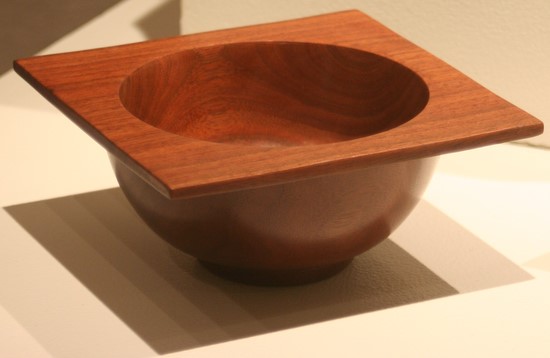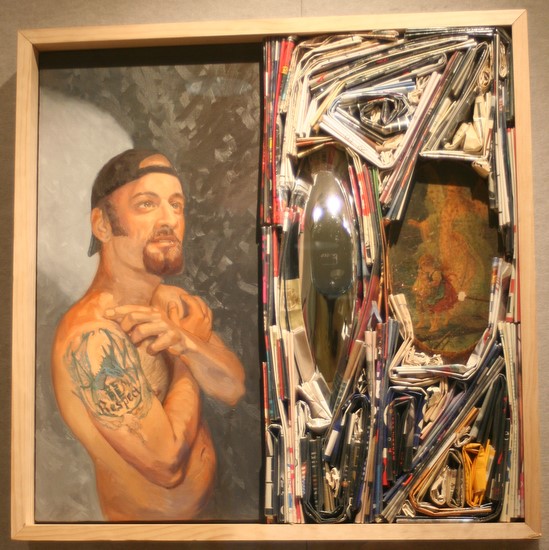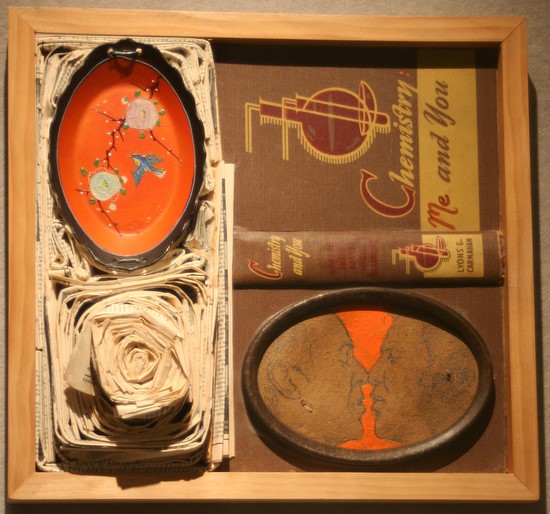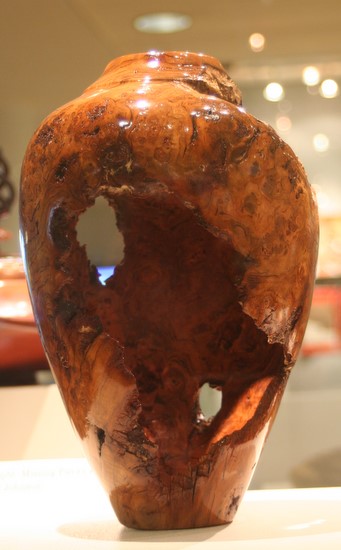 David Johnson's vase is missing large chunks.
David Johnson's vase is missing large chunks.
In the current Quad City Arts exhibit at the Quad City International Airport, the vase Missing Pieces #7 is symmetrical but for the voids that appear to have formed naturally through the growth and decay of its wood. Their jagged, random edges echo the blotchy rings of the wood grain, yet Johnson has varnished the entire surface, making it seem at once broken and new. The vase is not suitable for its ostensible purpose and seems to question the relationships between craft, aesthetics, and functionality. It's a striking use of the medium of wood.
The show, running through December, features two bodies of work: selections from the Quad Cities Wood Turners Club and mixed-media works by Jeff Stevenson. While the wood turners employ a relatively restrictive technique - modified wood in a functional context - Stevenson uses a massive range of media, from magazines to encaustic. The two components of the exhibit are different, but they both transcend the limitations of their methods: The best of the wood works (such as Johnson's vase) have visual and technical depth, and Stevenson's strongest pieces gel thematically and visually even as the variety of materials threatens chaos.
When choosing to work in a craft medium such as wood-turning, the artist strives for different objectives from a purely "fine artist," such as a painter or sculptor. Although there is the same emphasis on technique and skill, different rules of aesthetics apply. Their creations might be evocative, referential, or communicative, but these will always be viewed through a functional lens.
Many of the turners have developed a signature style of recurring silhouettes, types of woods, or textural approaches. Lyndel Anthony, for example, is showing three vessels with architectural motifs. The three containers have lids with symmetrical knobs and bulges influenced by the domes and spires atop Middle Eastern and Russian buildings. Bill McQuitty's vessels also pay homage to artisans of other cultures. His works all have stained or inlaid bands of repeating geometric shapes and lines encircling the center of the pot, as well as thinner bands near the mouths and feet. This use of repeating banded designs is reminiscent of the linear embellishments on ancient Greek pottery, or the shapes around Native American pots. These works demonstrate how craft, with its often ancient roots, is able to sustain and revitalize aesthetics of other cultures.
Other works in the show are neither referential nor fine art but demonstrate a strong understanding of contemporary design. Round but Square by Gene Vincent, for example, meshes craftsmanship, functionality, and style. This bowl has a round base, but its lip flares out into a flat, precise square. Vincent makes wise use of wood as a medium by incorporating the straight, linear grain into the perfectly square top of the bowl. While this work might not be as "artistic" as others, it offers a more sophisticated sense of design.
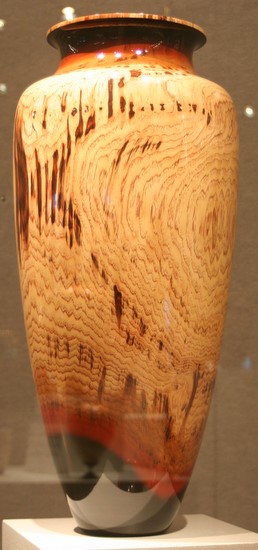 The most intriguing pieces in the show embrace the unique aspects of wood - its color, grain, and organic imperfections - and make them integral parts of the form. Most of the 30-odd vessels in this show demonstrate this technique to a degree, but only a quarter of them fully succeed. The first impression of Steve Sinner's and Joe Meirhaeghe's Hickory Vase is a function of it size - about two feet tall - and seemingly perfect symmetry. But the large, dark shapes in the wood grain really draw the viewer in. These blobs contrast with the light wood of the center of the vase, and against the medium tone of the wavy bands of wood grain. The artists echoed this dark color by staining the top and bottom of the vase a similar color. This work shows that turning skill, surface decoration, and the initial selection of material are equally important to a successful wood vessel.
The most intriguing pieces in the show embrace the unique aspects of wood - its color, grain, and organic imperfections - and make them integral parts of the form. Most of the 30-odd vessels in this show demonstrate this technique to a degree, but only a quarter of them fully succeed. The first impression of Steve Sinner's and Joe Meirhaeghe's Hickory Vase is a function of it size - about two feet tall - and seemingly perfect symmetry. But the large, dark shapes in the wood grain really draw the viewer in. These blobs contrast with the light wood of the center of the vase, and against the medium tone of the wavy bands of wood grain. The artists echoed this dark color by staining the top and bottom of the vase a similar color. This work shows that turning skill, surface decoration, and the initial selection of material are equally important to a successful wood vessel.
Jeff Stevenson's relatively chaotic art provides a stark contrast to the smooth, elegant contours of the wood forms. His mixed-media, two-dimensional pieces include such materials as oil paint, charcoal, pencil, collage, assemblage, and paint marker. Stevenson references social issues and personal narratives while exploring the use of found materials, symbolic imagery, and nonrepresentational surface treatment. These diverse materials, as well as his visual style, give his paintings a visual pop, and the array of imagery offers the viewer many references and ideas to consider. However, some works cross the line into confusion.
A strong work by Stevenson is the half-oil-painting, half-assemblage piece titled Respect. The left side of the image is a realistic, waist-up portrait of a man standing with his arms lightly crossed over his chest, with his hands on his collarbone. He appears to be nude but for a backwards baseball cap, and he has a large tattoo on his arm featuring the word "Respect." The man's goatee, sideburns, cap, and tattoo all place him as a contemporary man who would fit into a slightly alternative "tough guy" culture. However, his serene facial expression and upward gaze make him appear calm and reverent. On the right side of the piece is an assemblage containing magazines, a silver dish, and a Victorian-era illustration of children. The magazines could reference the assumed interests of the man, but the dish and illustration suggest a softer, more domestic side. The objects were wisely chosen, with clear social associations and an interesting rapport with the oil portrait. Respect inspires multiple yet related interpretations: the conflicts between self and societal image, between manliness and respectability, and between desires and responsibilities.
Chemistry is initially attractive because of the strong unity of colors, shapes, and textures. Aged paper folded and formed into concentric circles and rectangles on the left side matches the faded cover of an old chemistry textbook in the top right. The shape of a serving dish in the top left coincides with the oval-framed drawing of two men in the bottom right. The light, warm wood of the frame ties everything together. This work is conceptually interesting, as well, when the viewer notices that the two men's faces are only millimeters apart, with eyes closed, apparently going in for a kiss. Although approaching an intimate moment, the men are not drawn in a flowery or emotional way - the image appears more clinical than erotic. The bold word "Chemistry" above them on the altered textbook (changing the title from Chemistry & You to Chemistry: Me & You) references romantic chemistry along with the scientific discipline. The joining of science and homosexuality appears to allude to the debate over whether sexual orientation is a choice or natural disposition, and the age of the textbook perhaps reflects how knowledge and attitudes change over time.
In these works, Stevenson's choice and handling of media align strongly with a theme. Other pieces, especially the smaller mixed-media works on LP covers, are full of compelling visual textures and design motifs but seem to meander conceptually. They are certainly visually dynamic - with the radial explosion of lines of collaged text in Fruit, for instance, or the organic collaged shapes in Inheritance - but it's difficult to make a connection between some of the depicted objects. Cryptic or nonspecific imagery can work in art when it's employed within a strongly established visual or conceptual framework, but the absence of a clear theme in some of Stevenson's work only frustrated this viewer. I hope to see him develop his visual style to more consistently complement his ideas about contemporary culture.
Michelle Garrison is a mixed-media artist who teaches art and design at Geneseo Middle School and J.D. Darnell High School. She can be reached at michelle_m_garrison@hotmail.com.

